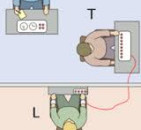A social psychology experiment conducted by Yale University psychology professor Stanley Milgram between 1961 and 1963 to measure the degree to which a participant will obey an authority figure despite performing tasks that conflict with their morals. The experiment consists of three figures, the authority figure who provides instructions to the participant, the participant who plays the teacher role, and an actor who plays the student role. In this experiment, the participant (teacher) was instructed to deliver shocks in increasing 15-V intervals to the learner for every incorrect answer that was given. The starting leveel was at 15 volts (labeled “slight shock” on the machine) and going all the way up to 450 volts (“Danger: severe shock”). As the voltage increased, the actor would plead the participant to stop, show signs of intense pain, and eventually cease to respond. If the teacher ever asked to stop the experiment, the authority figure issued commands to prod the participant along:
- "Please continue."
- "The experiment requires that you continue."
- "It is absolutely essential that you continue."
- "You have no other choice, you must go on."
Until they emerged from the lab, the participants didn’t know that the shocks weren’t real, that the cries of pain were pre-recorded, and that the learner was in on the whole thing, sitting alive and unharmed in the next room. They were also unaware that they had just been used to prove the claim that would soon make Milgram famous: that ordinary people, under the direction of an authority figure, would obey just about any order they were given, even to torture.
The experiment attempted to show humanity's darkside that the capacity for evil lies dormant in everyone, ready to be awakened with the right set of circumstances. As a result, Milgram experiment has been used to explain atrocities from the Holocaust to the Vietnam War’s My Lai massacre to the abuse of prisoners at Abu Ghraib.
In recent years, an increasing number of psychologists disagreed with Milgram's conclusions saying the results were as much a product of their time as they were a product of his research. At the time Milgram began his studies, the trial of Adolf Eichmann, one of the major architects of the Holocaust, was already in full swing. In 1963, the same year that Milgram published his studies.
- Part of Speech: proper noun
- Industry/Domain: Psychology
- Category: Social psychology
Creator
- amy.situ
- 100% positive feedback
(United States)
